Quetext is a plagiarism checker that has helped many identify plagiarized content in their articles, essays, and more.
Due to questions about its reliability in helping writers, editors, and students find plagiarism, it has caught our attention.
Several plagiarism checkers have made strong claims about the accuracy of their plagiarism detection.
This has invariably proved important to writers and professionals trying to avoid accidental duplication and want to ensure their writing stays clear from plagiarism accusations.
This being the case, we’ll take an in-depth look at Quetext’s plagiarism checking capabilities and see how accurately it discerns plagiarism patterns and content.
This will help you answer the question, “Is Quetext a good plagiarism checker?”
Key Takeaways
- Quetext uses DeepSearch™ tech to detect basic and advanced plagiarism types.
- It now includes AI detection, citation help, and a paraphrasing tool.
- Quetext failed to catch well-paraphrased plagiarism in testing.
- Its accuracy lags behind academic tools like Turnitin or premium detectors.
- The free plan is limited to 500 words and just 3 checks monthly.
- Best suited for casual content writers, not rigorous academic use.
What Is Quetext?

Quetext, launched in 2012, has made a name for itself as a plagiarism detection and citation tool designed to ensure the originality of your writing.
This online plagiarism tool detects plagiarism in essays, research papers, articles, and other types of written content.
Via its specialized plagiarism-detection software application, Quetext provides services to over 5 million teachers, students, and professionals worldwide.
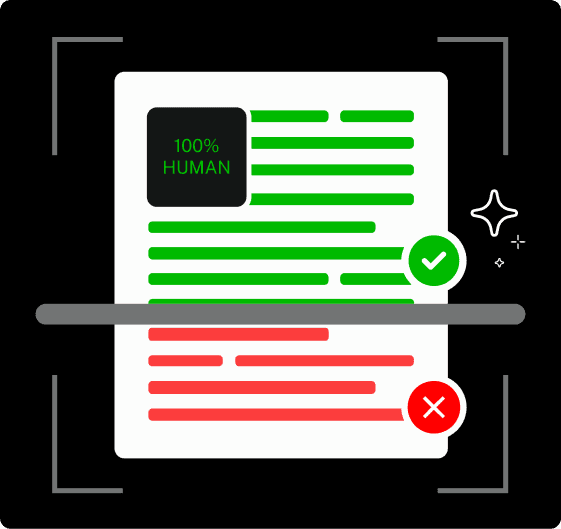
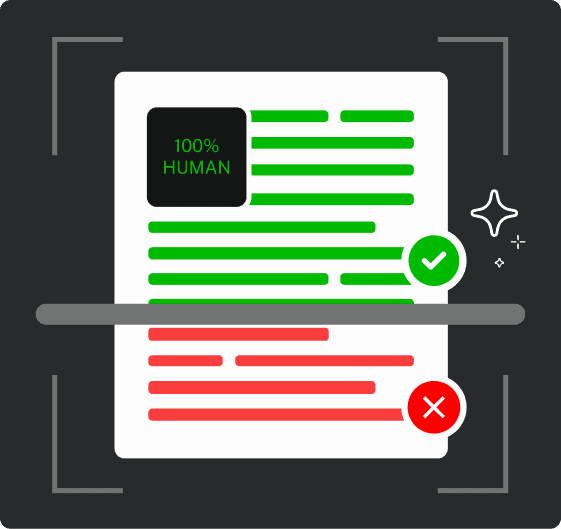
Never Worry About AI Detecting Your Texts Again. Undetectable AI Can Help You:
- Make your AI assisted writing appear human-like.
- Bypass all major AI detection tools with just one click.
- Use AI safely and confidently in school and work.
Originally, Quetext was focused solely on plagiarism detection, using its plagiarism tool to help content creators avoid and identify different types of plagiarism.
However, more recently, Quetext introduced AI content detection, due to the rise of AI content generation, from writing that may have been generated by tools like ChatGPT.
Quetext Features
Although Quetext primarily serves as a plagiarism checker, over the years, it has incorporated and offered valuable features to its users.
- Plagiarism Detection (DeepSearch™ Technology)
- AI Content Detection
- Color-Graded Feedback
- Citation Assistance
- Downloadable Reports
- AITutorMe Paraphrasing Tool
- Source Exclusion
- Plagiarism Detection (DeepSearch™ Technology): This is Quetext’s flagship feature, which uses its proprietary DeepSearch™ engine to analyze your text and identify plagiarism. It claims not to get fooled easily, and is great for catching the sneaky stuff.
- AI Content Detection: This AI detector performs detailed, line-by-line analysis to identify AI-generated content. This feature is ideal for educators, editors, or anyone who needs to verify the authenticity of written content.
- Color-Graded Feedback: This provides visual indicators to help you easily identify different types of matches and their severity levels. Red highlights mean high-risk plagiarism, while orange or yellow might indicate partial or paraphrased matches.
- Citation Assistance: This feature is particularly attractive to those in academic fields such as researchers, students and educators. You can get citation suggestions on various citation styles, making it easy to credit your sources properly.
- Downloadable Reports: For easy sharing, users can generate and export detailed plagiarism reports for academic submissions, editorial review, or client work where transparency matters.
- AITutorMe Paraphrasing Tool: Perhaps Quetext finds plagiarized text in your content, users can use the AITutorMe to paraphrase content quickly. This makes your writing process more efficient and stress-free.
- Source Exclusion: You can use this feature to exclude specific URLs or domains from plagiarism checks when appropriate, such as sources referencing common knowledge.
How Does Quetext Plagiarism Checker Work?
Quetext uses artificial intelligence and its advanced DeepSearch™ technology to provide accurate and thorough plagiarism checks.
Unlike standard plagiarism checkers that rely on basic keyword matching, Quetext’s DeepSearch™ conducts a scan for both surface-level matches and intricate content similarities across the vast expanse of the internet.
With this technology, Quetext claims to catch any form of plagiarism, be it the patchwork type, accidental type, or even self-plagiarism.
Quetext’s in-house technology quickly searches across billions of documents in its database, containing blogs, academic journals and papers, articles and others.
After its scan, Quetext presents to you a detailed plagiarism-based report. You can download and share this report.
You don’t just get a highlighted plagiarism check, but also citations where necessary with sources and a likelihood percentage.
How To Use Quetext
Using Quetext is quite straightforward, especially following the steps below.
- Create an account to use its limited free plan.
- Next, you paste or upload your text into the plagiarism checker.
- Quetext scans the web and academic databases to give you an answer. However, for a deep search, you’ll need to subscribe.
- Once the scan is done, it shows you exactly where it found potential issues using color-coded highlights.
- You can click on each highlight to see which source it matched with and how close the similarity is.
- Quetext suggests proper citations (APA, MLA, Chicago). So if you borrowed a line from an article or paper, you can quickly make it legit.
- Once everything’s checked, you can generate a detailed report, which is handy if you’re turning in an assignment.
Testing Quetext
Now, we’ll be running tests on Quetext’s plagiarism checker and also use our Plagiarism checker to verify its accuracy.
For this test, we’ll be making use of the premium industry-acclaimed test methodology used by ZDNet.
Based on ZDNet’s test of our platform and Plagiarism checker, we came out with a 100% accuracy on all accounts.
Without further ado, let’s run similar tests on Quetext and see how well it performs.
The Test
First Test
This test will have a paraphrased plagiarized text from The Guardian UK.
Note that the text has been paraphrased using our paraphrasing tool. We’d like to see how well the checker can find plagiarism when the text has been paraphrased.
Quetext: No Plagiarism.
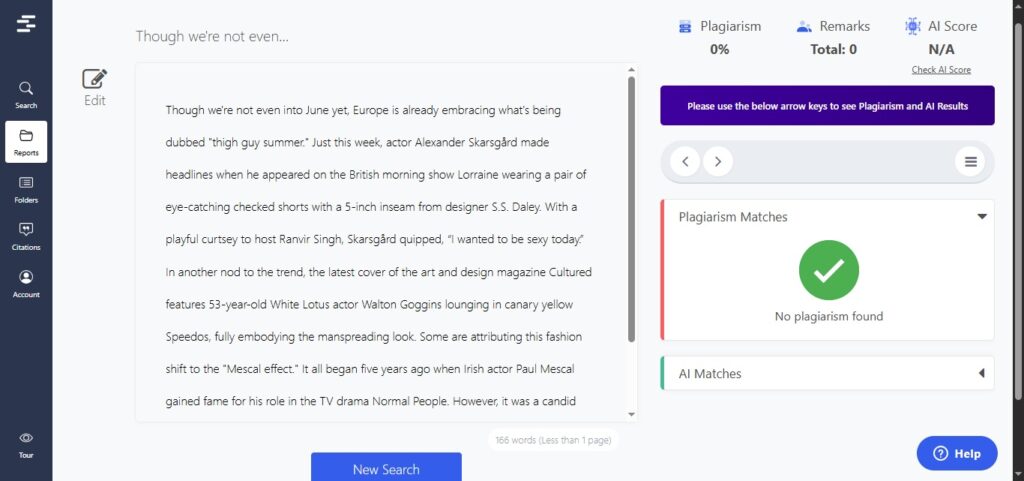
Quetext seems to recognize the text as original without any trace of plagiarism found.
This result shows that although Quetext claims to catch various types of plagiarism, when the text is paraphrased, it can still fail.
Undetectable AI Plagiarism Checker: 99% Human, no plagiarism.
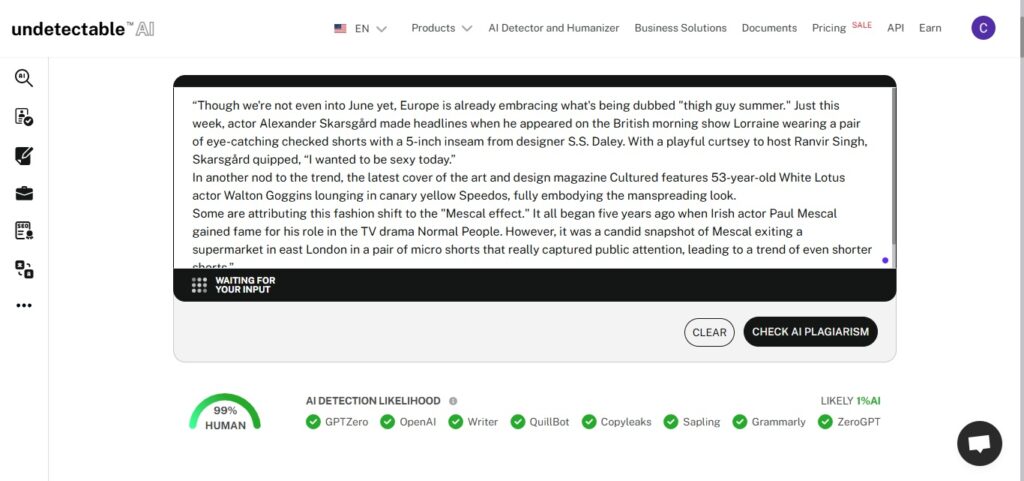
Our checker could also not find plagiarism in the text paraphrased using our paraphrasing tool.
Hence, undetectable AI can help your text become undetectable and bypass plagiarism, rewriting your content with a unique human tone.
Second Test
For the second test, we ran an essay excerpt that references various sources but hasn’t been modified.
Quetext: 82% Plagiarism
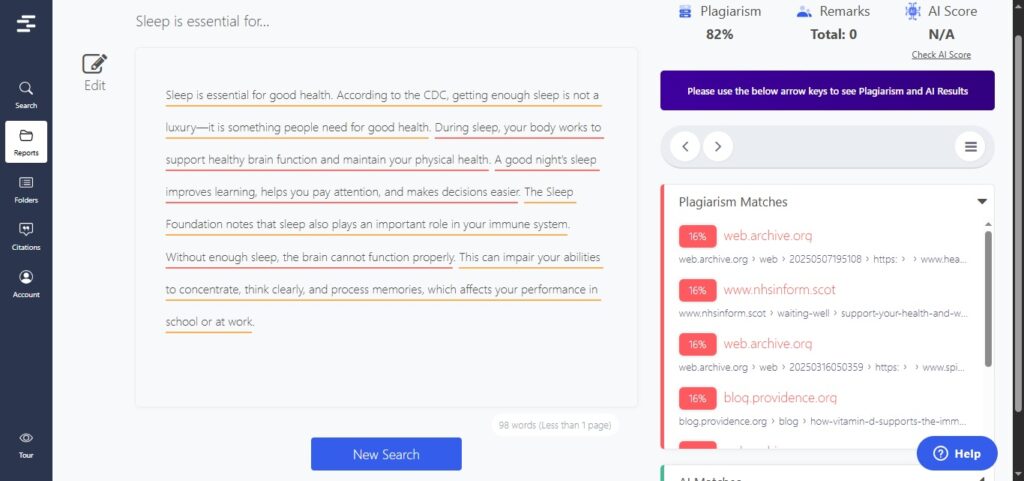
Through the test, Quetext was able to find several related sources, identifying high to medium cases of plagiarism.
However, its plagiarism percentage is low compared to our plagiarism checker’s analysis.
Undetectable AI Plagiarism Checker: 99% AI plagiarism.
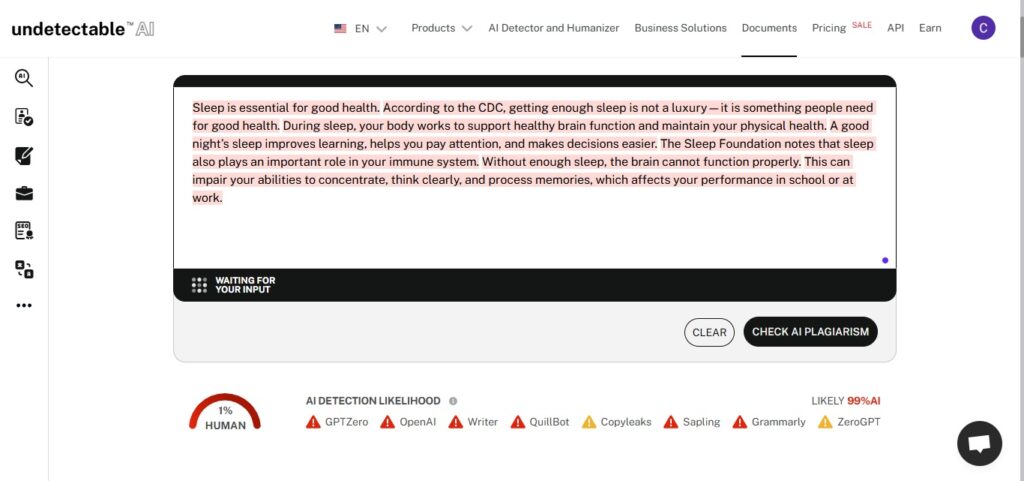
On the other hand, our plagiarism checker found a 99% plagiarism likelihood throughout the same text.
Hence, presenting a higher accuracy compared to Quetext.
Is Quetext a Good Plagiarism Checker?
From our testing, it can be seen that Quetext is an okay plagiarism checking tool.
It’s fast and helps you understand what kind of plagiarism you’re dealing with in your text.
Nonetheless, it’s not all so accurate at flagging plagiarized text once a good paraphrasing tool like ours is used, because this paraphrased text can bypass its detection easily.
Moreover, Quetext could provide the wrong sources to a potentially plagiarized text, lacking contextual clues, thereby giving users an inaccurate plagiarism score.
Still, for a largely plagiarized and not paraphrased text, Quetext can easily catch it and produce a string of possible sources.
In summary, Quetext is good, not excellent. You will have to use the premium version to get a more accurate plagiarism analysis and access better features.
Quetext Limitations
Quetext has gotten praise over the years for its plagiarism checking.
Nevertheless, it’s severely limited in these areas:
- Limited Free Plan: The free version only allows up to 500 words per check and 3 checks total per month. That’s barely enough to scan a decent blog post before hitting a paywall. You’ll need to upgrade to Pro for anything serious and longer documents.
- Limited Database: Quetext covers thousands of web pages and publications, but it doesn’t have access to the same massive academic databases (like JSTOR, ProQuest, or private institutional archives) that Turnitin uses. Hence, some scholarly sources might slip through the cracks.
- Slow Scanning: While testing short documents, Quetext was a bit slow but tolerable. However, scanning large documents (especially over 25,000 words) can take longer than expected. This is not a deal-breaker, but the wait might get annoying.
- Potential Misidentification: Sometimes, content writers may write exact text without intention, so Quetext may detect plagiarism, also, its algorithm may mislead users. This suggests the system may flag original content that happens to match existing sources as evidence in our test.
- False Positives: False positives, where legitimate content is flagged as problematic, can and often occur. Like most AI detectors, Quetext’s accuracy can be hit or miss. So, users can use it as a helpful guide to edit visible traces of plagiarism.
How Does Quetext Compare to Other Plagiarism Checkers?
While Quetext is a strong contender, there are other plagiarism checkers that can compete confidently against it.
- Turnitin: Turnitin is the gold standard AI plagiarism checker for checking academic plagiarism. It’s used by universities around the world and boasts the largest private database of student papers, scholarly articles, journals, and institutional documents.
It excels at detecting deep plagiarism, including well-disguised paraphrasing and AI-generated content. A downside to Turnitin is that it’s not available for individual use. You can only access it through a school or organization. - Copyscape: Copyscape is more of a niche tool compared to Quetext and Turnitin. It has a laser-focused check in finding duplicate content across websites and blog pages. It’s not meant for essays or in-depth academic work.
Instead, it’s used heavily by SEO experts, marketers, and bloggers to detect stolen or copied web content. It only flags exact matches, so if you slightly rewrite your work, Copyscape might miss it. - Undetectable AI Plagiarism Checker: Unlike the others, our AI plagiarism checker is a newer tool designed to help users know if their content can be flagged as AI-generated. It doesn’t check for traditional plagiarism or citation issues. Instead, it analyzes the sentence structure, predictability, and stylistic variations to determine whether something sounds like it was written by an AI model.
That’s not all that we offer.
With undetectable AI Detector and Humanizer, you can convert your AI-generated and edited content to remain original, sound human-like and even possibly exceed Quetext’s reliability as shown in our tests.
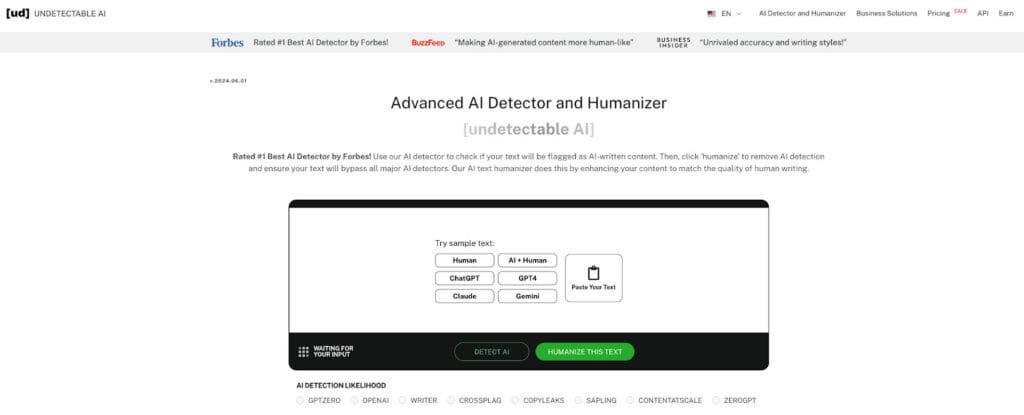
Furthermore, if you’re stuck and facing writer’s block, you can easily use our AI Stealth Writer as a reliable tool to generate content that is secure and stealthy enough to bypass detectors.
This top can help you with technical writing and other forms of writing. Not just that, your privacy is assured.
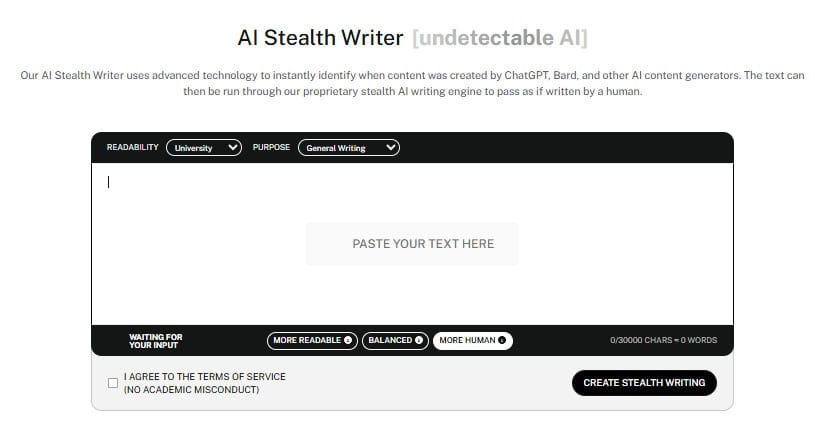
Who Should Use Quetext?
Anyone with access to the internet can use Quetext, however, it’s best used for its specialized purpose, especially for the people it’s designed for.
Those who should use Quetext include:
- Students
- Freelance Writers and Ghostwriters
- Bloggers and Website Owners
- Educators and Tutors
- Self-Publishing Authors
- Content Agencies
Experience the power of our AI Detector and Humanizer in the widget below!
FAQs About Quetext
Is Quetext Reliable For Academic Papers?
This depends on the level of academic writing. For high school or undergraduate assignments, Quetext is reliable.
However, if you’re submitting a thesis, dissertation, or journal article, Quetext won’t catch academic journal matches, institutional paper submissions, or scholarly citations.
Is Quetext Free For Unlimited Use?
No. Quetext has a limited free version, which allows 3 searches per month with a 500-word cap per check.
If you want unlimited use, longer word counts, DeepSearch capabilities, and citation tools, you’ll need the Pro plan.
How Accurate Is Quetext’s Plagiarism Detection?
Quetext is above average when it comes to detecting standard web plagiarism and catching paraphrased content using its DeepSearch™ technology.
Its accuracy is best for general web content, not academic literature.
Does Quetext Store My Documents?
No, according to Quetext’s official privacy policy, it does not store, publish, or share your uploaded content.
The documents you scan are not indexed or added to their database unless you give explicit permission.
Hence, your documents stay private unless you choose to keep a saved copy in your account.
Final Verdict: Is Quetext Worth Using?
Perhaps after all this, you’re wondering, “Is Quetext legit and worth your time?”.
Quetext is worth using for specific scenarios, but comes with important caveats that potential users must consider for critical academic applications where precision is paramount.
On the whole, Quetext represents a middle-ground solution that’s worth considering if you need affordable dual-functionality of plagiarism and AI detection.
Using our AI plagiarism checker is another worthy option for you to consider.
